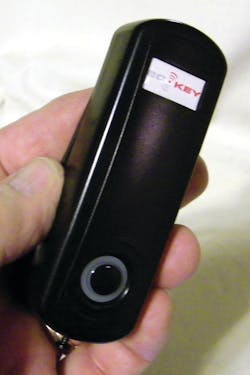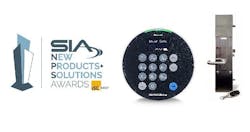Bluetooth technology is a global wireless protocol enabling, convenient connectivity for an expanding range of devices and services. It is being adapted by the security industry as an access control credential, enabling Bluetooth mobile devices (Smartphones) to be used as credentials instead of a plastic credential.
Bluetooth was created by Swedish company Ericsson in 1994, intended to be a wireless alternative to RS-232 data cables. The name Bluetooth is derived from the 10th century Danish King Harald Blåtand or Harold Bluetooth in English. King Blåtand helped unite warring factions in parts of what are now Norway, Sweden and Denmark.
Bluetooth technology is a combination of both hardware and software. Bluetooth compatible devices have both a Bluetooth chip and the associated firmware.
Bluetooth technology exchanges data over short distances using radio transmissions. Bluetooth technology operates in the unlicensed industrial, scientific and medical (ISM) band at 2.4 to 2.485 GHz, using a spread spectrum, frequency hopping, full-duplex signal at a nominal rate of 1600 hops/sec. The 2.4 GHz ISM band is available and unlicensed in most countries. Bluetooth’s adaptive frequency hopping (AFH) capability reduces interference between wireless technologies sharing the 2.4 GHz spectrum. AFH works within the spectrum to take advantage of the available frequency. Bluetooth technology detects other devices in the spectrum and avoids the frequencies they are using. This adaptive hopping among 79 frequencies at 1 MHz intervals gives a high degree of interference immunity and also allows for more efficient transmission within the spectrum.
Unlike other RF technologies, Bluetooth has a limited bandwidth and range. However, the hardware is inexpensive and uses very little current, making it well suited for battery operated devices.
Pairing is configuring two Bluetooth devices to communicate. The process is a little different for each Bluetooth device, but typically only takes a couple of minutes.
The range of Bluetooth technology is application-specific. Range may vary depending on class of radio used in an implementation:
Class 3 radios –– Up to 1 meter or 3 feet
Class 2 radios (most commonly found in mobile devices) –– 10 meters or 33 feet
Class 1 radios (used primarily in industrial use cases) –– 100 meters or 300 feet
ECKey uses Bluetooth devices such as smartphones instead of credentials to control access. ECKey Smartphone Readers work with all access control systems and improve security compliance as people are less likely to share their Smartphone and quickly know when it has been misplaced.
ECKey readers have an adjustable read-range up to 30’ (10M), convenient for garages and gates, and can be mounted on the secure side of the door, away from vandals and the elements saving installation and maintenance costs.
The ECKey connects to the access controller by 5 wires, the same as a conventional cardreader.
ECKey has two model readers: Enterprise and Standalone.
Enterprise Features:
- Easily integrates with existing Wiegand access systems
- Patented read-range control from 1‘ to 30’ (10M)
- Bluetooth works when Wi-Fi and cellular don’t
- Smartphone apps for convenience and administration
- Remote input for discreet mounting
- Low Power Consumption
ECKey Standalone Readers connect directly to an electric door locking device, eliminating expensive panels and complex networks. All you need is power…and not much. The adjustable, long read-range lets you mount readers in a safe, secure environment out of sight away from weather and vandals,
All ECKey products can be managed from a Smartphone and remote visitor management is easy with another ECKey product VIZpin®.
Features include:
- Scalable from 1-1,000 doors
- Unlimited users and Remote Visitor Management with VIZpin®
- 1,500-event Audit Trail
- Bluetooth works when Wi-Fi and cellular don’t
- 25 Non-Smart Phone users
- Patented read-range control from 1‘ to 30’ (10M)
- Remote inputs for discreet mounting
- Multi-Color LED and buzzer
- Low Power AC/DC
Q&A: ECKey’s Mike Day
Locksmith Ledger contacted ECKey’s Technical Specialist Mike Day to learn about these products. Following are our questions and Day’s answers.
Can you tell us a little about your background?
My title is Technical Specialist. Responsibilities include product management, technical support (on site, phone, email) and instructor for Certified Partner Trainings. My education is in network administration and I have held technical positions in the video management side of our industry at IQinVision and Vicon before joining ECKey in September 2012.
Can you tell us about ECKey's history?
ECKey designs, manufactures and markets Smartphone Access Control systems and components, Smartphone apps and hosted services. Originally founded in New Zealand in 2005 by Dr Nick Willis, ECKey was incorporated in the U.S. in 2008 and moved all operations to the United States in 2012.
What products do you offer?
Hardware: EK6 and EK7 Bluetooth readers. Services/apps: VIZpin, a cloud-based remote visitor management system.
Where can they be purchased?
Through our certified dealer and distribution partners found here:http://eckey.com/find-certified-partner/
What are the differences between the EK-6 & EK-7?
The EK6 ties to an access control system and will generate and send a virtual card number via Wiegand data. Out of the box, the reader can be configured for 26 or 48 bit Wiegand, or just send the raw Bluetooth address of the phone. We can also do custom Wiegand formats when required (via custom firmware).
The EK7 has an internal relay and controls a door/gate/lock directly.
What is required for a basic installation?
For the EK6: access control system and power supply. For the EK7: electric lock/strike/door opener and power supplies. In both cases, PC software is needed to change settings over a Bluetooth connection.
Does the reader work with credentials or only Bluetooth devices?
A Bluetooth device is always required. Typically this is a Smartphone, but can also be most any phone, tablet, laptop, GPS, car kit, or 3rd party fob with Bluetooth.
The ECKey readers can be configured to trigger simply when the Bluetooth device is in range. They can also be configured for keypad mode (PIN entry on the phone) or when an external trigger is activated (pushbutton, loop detector, IR motion detector).
What role does the ECKey Management Application play?
The ECKey Management Software is used for configuring the ECKey readers. Some of the most common settings to change are PINs, relay options, device-specific range, and site code and Wiegand bit format on the EK6.
Does it install on a smartphone or a PC/Laptop?
The ECKey Management Software is for PC/laptops (Win7). We also offer the ECKey Manager App for Smartphones to administer ECKey readers.
We also have free Unlock Apps for iOS and Android. The Unlock App is a simple way to make your phone discoverable and trigger an ECKey reader. The same thing can be done manually through the phone settings, but the Unlock App makes this much more convenient.
Lastly, we have the VIZpin user app. This is how a user would utilize the VIZpins that were issued to him from a site administrator. After a VIZpin has been issued through the cloud, the user simply taps the UNLOCK button when he is close to the ECKey reader and the door unlocks.
Does the PC/Laptop need to be onsite?
No. You could easily connect to and configure the reader in your office, save the settings and then install it at the site. ECKey Management Software also offers OFFLINE mode – this allows you to create a Profile of settings without actually connecting to a reader. This Profile can then be quickly applied to a reader that is already installed.
Does the reader report opening alerts, or exceptions?
ECKey readers have an internal audit trail. They can be configured to store events such as unlocks, pairing requests, failed PIN entries, resets, tampers and administrative changes. Also, the readers have a tamper switch and door position sensor to alarm when the reader is manipulated or the door is held open too long.
How many unique Bluetooth devices can be paired with the EK6?
The EK6 or EK7 can have up to 25 paired users, but we can also work with non-paired devices while still maintaining security. An access control system with an EK6 accomplishes this, as does using VIZpin with either reader model.
Can a laptop be used to administer the reader in both standalone mode or when it is used as a reader in conjunction with an external EAC?
We can connect to both ECKey reader models, EK6 or EK7, via Bluetooth or USB connection from a PC/laptop. The Bluetooth dongle (no longer offered) and USB cable are optional add-ons. Most embedded or 3rd party Bluetooth radios should be able to connect to the ECKey readers for administration.
How do you determine if a smartphone is compatible with your product before buying the smartphone?
I can think of no reason why any current Smartphone would not work with our readers. Most any Bluetooth device (flip phone, Smartphone, tablet, laptop, GPS, car kit, or Bluetooth fob) should work so long as it is Bluetooth 2.0 compatible. We’re looking into the latest BT technology for new products, but current BT radios that utilize BLE (Bluetooth low energy/4.0) are almost always backwards compatible.
For more information, visit www.eckey.com.
Viking Bluetooth Door Controller
The Viking BTC-1 allows a user to actuate a door strike or door controller by touching an icon on their Bluetooth-enabled Android phone or tablet. The BTC-1 can be preprogrammed with the type of contact needed, NO or NC, and the duration of the contact from 0.5 to 120 seconds. Continuous on is also supported.
Security is maintained by way of encrypted communication as well as a programmable Security key. The unit name is also user changeable to allow the use of multiple BTC-1’s. All programming can be done through the free Android application available on Google’s Play Store.
The unit has an LED status indicator that shows if the unit is paired with a device, in programming, or idle. The BTC-1 is small enough to fit on a door frame and it can be powered from the door strike power supply.
Typical Applications are: gates, doors, condominiums, apartment buildings and commercial.
Features include:
- Small size, can fit on a door frame
- Wide supply range 12-24 VAC/VDC
- Programmable One touch operation
- LED status indicator
- Programmable Security key
- Programmable Contact N.O. or N.C.
- Programmable Contact time .5 to 120 seconds
- Easy to use application software
Specifications:
- Power: 12 to 24 VAC or VDC
- Contact Rating: 2 amps at 24 volts AC or DC momentary, 1 Amp continuous
- Dimensions: 65mm x 35mm x 20mm (2.56” x 1.38” x 0.79”)
- Environmental: 0° to 32° C (32° to 90° F) with 5% to 95% non-condensing humidity
- Cover Color: Beige
- Connections: Three 18” long leads, 26 AWG
- Range: Up to 60 feet, depending on obstructions
- Pairings: Remembers up to eight pairings
For more information, visit www.vikingelectronics.com.






